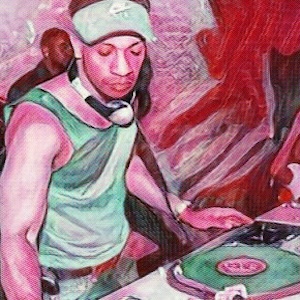

It is hard to imagine, but one of hip-hop’s true revolutionaries is a person whose name you may not know and whose face you would likely not recognize. Until recently, he has seemed to exist only in album credits–a deejay on one album, a producer on some others, and a remixer of singles here and there. But Prince Paul’s work has made an impact on the hip-hop universe, and though he stepped out front in the last couple of years, he is still one of rap’s most enigmatic and elusive figures.
So what has he done that is so special? For one thing, Paul brought hip-hop out of the era where the only thing that could be sampled was the same old “funky drummer” snippet from a James Brown record. The joints he produced featured samples from all kinds of crazy sources–Johnny Cash songs, jazz albums, TV shows, foreign language instruction records, whatever. He turned hip-hop records from a forum for old-school boasting into a new medium for psychedelic collage. Beyond that, he also invented the hip-hop skit. Granted, it didn’t take long for this particular feature of rap records to seem totally played out, but back when Paul inserted the game-show sections into De La Soul’s 3 Feet High and Rising, it was something totally new. Along with De La Soul, Paul also opened the way for a new spirit of positivity to enter the rap game.
Prince Paul was born Paul Huston on April 2, 1967 on New York’s Long Island. His love of music came from his father, a truck driver (now deceased) who played jazz records for his infant son. As a tribute, Paul included a sample of “Moody’s Mood for Love,” a favorite of his father’s, into his album A Prince Among Thieves. Paul’s mother was a home health aide. His upbringing was suburban and mostly without incident. He took clarinet lessons for a time, but quickly gave up. His musical heroes were funk musicians, such as George Clinton and his band Parliament-Funkadelic, and hip-hop forefathers like Biz Markie and Rakim. In junior high school, Paul began deejaying, and quickly showed his gift for innovation, dropping samples of television show theme songs into his mixes, and spinning records backwards for odd effect. Paul attended Amityville High School, ironically the same school attended by the members of De La Soul, though they didn’t know each other at the time. He earned a degree from Five Towns College and worked a day job at an insurance company called General Accident after graduating.
By night, however, Paul’s hip-hop dreams continued unabated. He played a house party in Brooklyn where members of the band Stetsasonic approached him about working with them. He produced the title track for their 1988 album In Full Gear. “Delight [of Stetsasonic] was like, ‘You gotta quit college ’cause Stetsasonic is going to blow up and you need more time with the group and you need to quit your job,’” Paul told Urb magazine. He refused, convinced that hip-hop, like so many musical trends, was just a passing phase.
Paul changed his mind in 1989 after producing De La Soul’s landmark album 3 Feet High and Rising. Its songs were far different from the self-promotional boasts and proto-gangsta threats that dominated the genre up to that point, and in-between them, Paul inserted unusual samples–Steely Dan and Hall and Oates–and hilarious quiz show questions like “How many feathers on a Perdue chicken?” The album was a critical and popular success, ultimately selling more than a million copies. The follow-up, De La Soul is Dead, was less successful, but still managed to earn gold status. Another collaboration, Buhloone Mindstate, was widely praised by critics, but rap’s ever-fickle public had moved on by then.
In his spare time, Paul had been producing and remixing tracks for the likes of Boogie Down Productions, Big Daddy Kane, and the most legitimate white rappers of their time, 3rd Bass. Following the split with De La Soul, Paul joined Wu-Tang Clan producer RZA, rappers Too Poetic and Fruitkwan, and formed Gravediggaz in 1994. The group released the album Six Feet Deep in 1994, and album that represented quite a turn for Paul, who up to that point had seldom dealt in gangsta clichs. Gravediggaz actually went past the violence and mayhem of most gangsta rap, though, creating a mix of over-the-top gore and heavy metal some dubbed “horrorcore.” Nevertheless, it produced the hit single “Diary of a Madman.” Paul, whose pseudonym in Gravediggaz is Undertaker, went on to make two more albums, The Pick, the Sickle, and the Shovel in 1997, and Scenes from the Graveyard in 1998.
Before those records came out, however, Paul took a step toward finally making a solo record. He combined samples of a psychoanalytic self-help album with the recorded dreams and fantasies–many of them incredibly explicit–of friends and various rappers, and turned it all into an album called Psychoanalysis (What Is It?). The disc shocked many who were not ready for an album from Paul that dealt with things like date rape and murder. “It was a joke that went too far,” Paul told the New York Times. “The next thing, I’m getting write-ups about people getting shocked. I thought that record was the end of my career. Next thing, all the work comes in.” Paul produced tracks for his old hero Biz Markie as well as Living Colour guitarist Vernon Reid and comedian Chris Rock (the Grammy-winning Roll With the New). “One reason Chris and I are friends is that we’re both nerds,” Paul told the New York Times.
After the Psychoanalysis album, Paul set out on a much more ambitious project. His 1999 album Prince Among Thieves was nothing short of a hip-hop opera. It has a story line running all the way through, laid out in between song skits and musical numbers that show off Paul’s mastery of many different hip-hop styles. The story involves a nascent rapper, Tariq, who needs $1,000 to finish a demo tape he is sending to Wu-Tang producer RZA. His best friend True hooks him up with some drug dealing associates, and soon the previously upright youth is seduced into selling vast quantities of dope for drug kingpin Mr. Large. True helps him buy a gun, a pimp named Count Mackula sets him up with a prostitute, and eventually, he is busted by the police. His mother sends a minister to bail him out, but when he hits the streets once again, he discovers that True has stolen his music and his appointment with RZA. As it turns out, it was True that had played him all along, setting him up in the drug game and then calling in his corrupt police buddies. Tariq finds True and the two shoot each other, but True survives because he was wearing a bullet-proof vest. Tariq, wounded but with nothing to live for, takes his own life. Though a grim tale, A Prince Among Thieves earned major critical praise and may someday become a movie; Chris Rock has negotiated to buy the film rights.
At the same time he was working on Prince, Paul was moving in another direction altogether. He teamed with deejay Dan “The Automator” Nakamura (of Dr. Octagon fame) in the group Handsome Boy Modeling School. The name is taken from an episode of Chris Elliot’s short-lived Fox television sitcom Get a Life. There is a loose concept to the album, but basically, it is a framework for Paul’s wildly entertaining tracks, featuring cameo appearances by Grand Puba, Sadat X, Encore, DJ Shadow, Cibo Matto’s Miho Hatori, Sean Lennon, Del tha Funky Homosapien and Beastie Boy Mike D. Like A Prince Among Thieves, How’s Your Girl was named on many critics’ lists of the best recordings of 1999.
Despite all his success, Paul seems able to keep it all in perspective. As he told Urb, “People are like ‘Yo Paul, you’re like a legend.’ It doesn’t sink in. I’m happy that I have the opportunity, but I still live by how-long-is-this-going-to-last? I’ve seen the roller coaster up and I’ve seen it down, so I never want to get too comfortable with success.”
Leave a Reply
You must be logged in to post a comment.